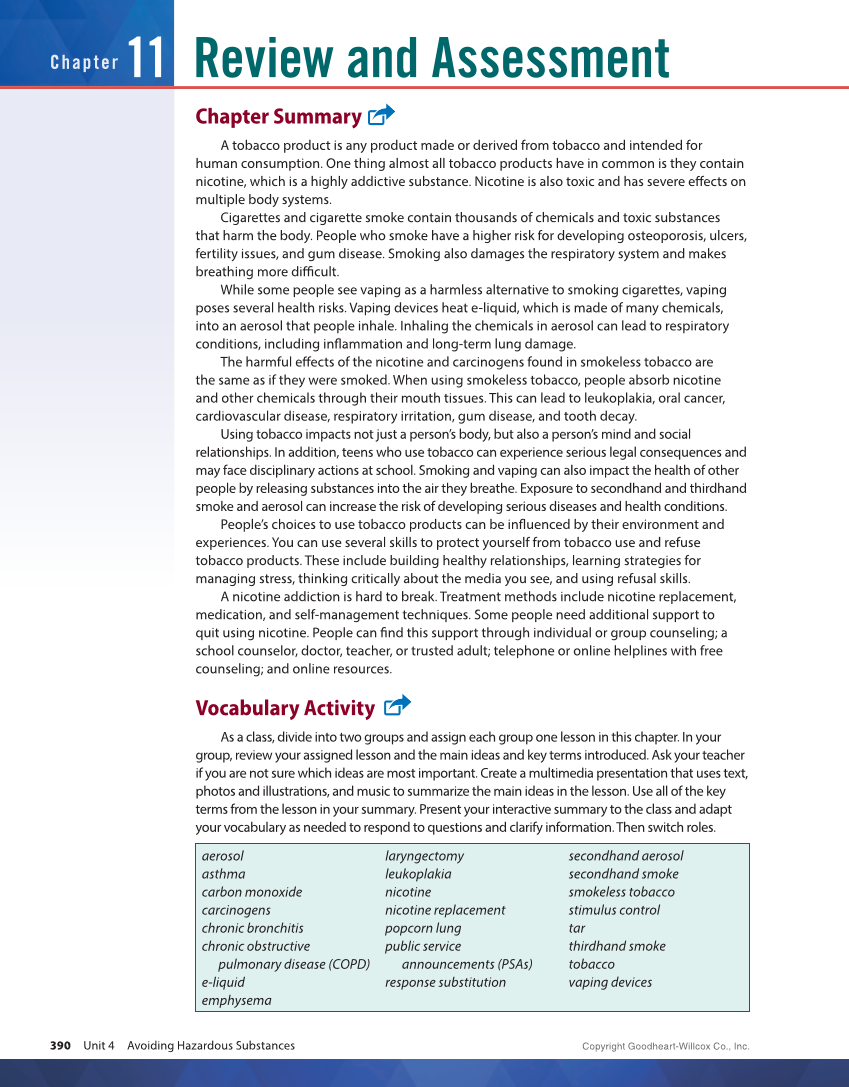Chapter 11 Review and Assessment Chapter Summary A tobacco product is any product made or derived from tobacco and intended for human consumption. One thing almost all tobacco products have in common is they contain nicotine, which is a highly addictive substance. Nicotine is also toxic and has severe effects on multiple body systems. Cigarettes and cigarette smoke contain thousands of chemicals and toxic substances that harm the body. People who smoke have a higher risk for developing osteoporosis, ulcers, fertility issues, and gum disease. Smoking also damages the respiratory system and makes breathing more difficult. While some people see vaping as a harmless alternative to smoking cigarettes, vaping poses several health risks. Vaping devices heat e-liquid, which is made of many chemicals, into an aerosol that people inhale. Inhaling the chemicals in aerosol can lead to respiratory conditions, including inflammation and long-term lung damage. The harmful effects of the nicotine and carcinogens found in smokeless tobacco are the same as if they were smoked. When using smokeless tobacco, people absorb nicotine and other chemicals through their mouth tissues. This can lead to leukoplakia, oral cancer, cardiovascular disease, respiratory irritation, gum disease, and tooth decay. Using tobacco impacts not just a person’s body, but also a person’s mind and social relationships. In addition, teens who use tobacco can experience serious legal consequences and may face disciplinary actions at school. Smoking and vaping can also impact the health of other people by releasing substances into the air they breathe. Exposure to secondhand and thirdhand smoke and aerosol can increase the risk of developing serious diseases and health conditions. People’s choices to use tobacco products can be influenced by their environment and experiences. You can use several skills to protect yourself from tobacco use and refuse tobacco products. These include building healthy relationships, learning strategies for managing stress, thinking critically about the media you see, and using refusal skills. A nicotine addiction is hard to break. Treatment methods include nicotine replacement, medication, and self-management techniques. Some people need additional support to quit using nicotine. People can find this support through individual or group counseling a school counselor, doctor, teacher, or trusted adult telephone or online helplines with free counseling and online resources. Vocabulary Activity As a class, divide into two groups and assign each group one lesson in this chapter. In your group, review your assigned lesson and the main ideas and key terms introduced. Ask your teacher if you are not sure which ideas are most important. Create a multimedia presentation that uses text, photos and illustrations, and music to summarize the main ideas in the lesson. Use all of the key terms from the lesson in your summary. Present your interactive summary to the class and adapt your vocabulary as needed to respond to questions and clarify information. Then switch roles. aerosol asthma carbon monoxide carcinogens chronic bronchitis chronic obstructive pulmonary disease (COPD) e-liquid emphysema laryngectomy leukoplakia nicotine nicotine replacement popcorn lung public service announcements (PSAs) response substitution secondhand aerosol secondhand smoke smokeless tobacco stimulus control tar thirdhand smoke tobacco vaping devices Copyright Goodheart-Willcox Co., Inc. 390 Unit 4 Avoiding Hazardous Substances
